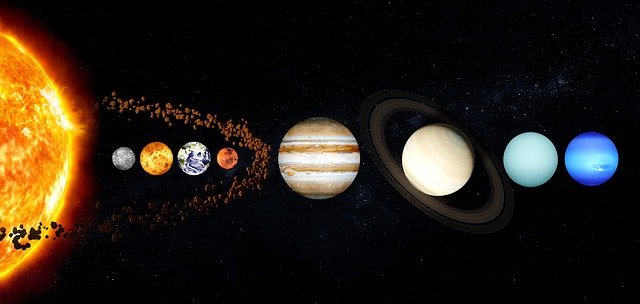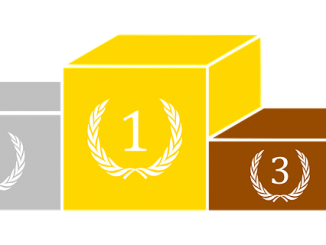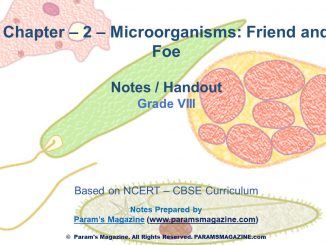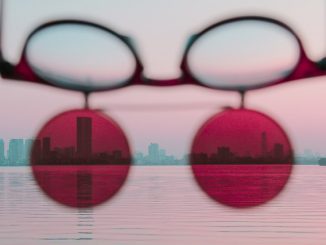
Notes / Handout – Stars and the Solar System – Chapter – 17 – Class-8 – CBSE
Celestial Bodies
- The stars, the planets, the moon and many other objects in the sky are called celestial bodies
Astronomy
- The study of celestial objects and associated phenomena is called astronomy.
- In olden days, people observed the passage of the Sun, stars, moon and planets in the sky to devise calendars and almanacs.
- It helped people in their day to day conduct and a better understanding of climate and rainfall patterns for timely sowing and choice of crops, fixing the dates of seasons and festivals.
The Moon
- The various shapes of the bright part of the moon as seen during a month are called phases of the moon.
- Month – The time period between one full moon to the next full moon is slightly longer than 29 days. In many calendars this period is called a month.
Why do stars appear smaller?
- The stars are millions of times farther away than the Sun. Therefore, the stars appear to us like points.
Distance of the Sun from the Earth
- The Sun is nearly 150,000,000 kilometres (150 million km) away from the Earth.
Nearest star
- The next nearest star is Proxima Centauri. It is at a distance of about 40,000,000,000,000 km from the Earth.
Light year
- It is the distance travelled by light in one year.
- The distance of the Sun from the Earth is about 8 light minutes.
- The distance of Alpha Centauri is about 4.3 light years.
Constellation
- The stars forming a group that has a recognisable shape is called a constellation.
- Constellations were devised by ancient people to recognise the stars in the sky. The shapes of constellations resemble objects familiar to those people.
- Great Bear
- Orion
- Cassiopeia
- Leo Major
- The constellation appears to move in the sky from east to west.
Great Bear (Ursa Major)
- One of the most famous constellations which you can see during summer time in the early part of the night is Ursa Major. It is also known as the Big Dipper, the Great Bear.
- There are seven prominent stars (Merak, Dubhe, Megrez, and Phecda, Alkaid, Mizar, and Alioth) in this constellation. It appears like a big ladle or a question mark. There are three stars in the handle of the ladle and four in its bowl.
Pole star
- The Pole star is not visible from the southern hemisphere. Some of the northern constellations like Ursa Major may also not be visible from some points in the southern hemisphere.
Orion
- Orion is another well-known constellation that can be seen during winter in the late evenings. It is one of
the sky. - It also has seven or eight bright stars
- Orion is also called the Hunter.
- The three middle stars represent the belt of the hunter. The four bright stars appear to be arranged in the form of a quadrilateral.
Sirius
- The star Sirius, which is the brightest star in the sky, is located close to Orion.
- To locate Sirius, imagine a straight line passing through the three middle stars of Orion.
Look along this line towards the east.
This line will lead you to a very bright star. It is Sirius.
Cassiopeia
- It is the constellation in the northern sky.
- It is visible during winter in the early part of the night.
- It looks like a distorted letter W or M.
The Solar System
- The Sun and the celestial bodies which revolve around it form the solar system.
- It consists of large number of bodies such as
- planets
- comets
- asteroids and
- meteors
The Sun
- The Sun is the nearest star from Earth.
- It is the source of energy on the Earth.
- It emits heat and light continuously and is the main source of heat and light for all planets.
What makes the planets revolve around the Sun?
- The gravitational attraction between the Sun and these objects keeps them revolving around it.
- The eight planets in their order of distance from the Sun are:
- Mercury
- Venus
- Earth
- Mars
- Jupiter
- Saturn
- Uranus and
- Neptune
Pluto
- Till 2006 there were nine planets in the solar system.
- Pluto was the farthest planet from the Sun.
- In 2006, the International Astronomical Union (IAU) adopted a new definition of a planet.
- Pluto does not fit this definition. It is no longer a planet of the solar system.
- The simplest method of identifying planets from stars is that stars twinkle, whereas planets do not.
- Also the planets keep changing their positions with respect to the stars.
Orbit
- A planet has a definite path in which it revolves around the Sun. This path is called an orbit.
Period of revolution
- The time taken by a planet to complete one revolution is called its period of revolution.
- The period of revolution increases as the distance of the planet increases from the sun.
Period of rotation
- The time taken by a planet to complete one rotation is called its period of rotation.
Satellite
- Any celestial body revolving around another celestial body is called its satellite.
Mercury
- The planet mercury is nearest to the Sun.
- It is the smallest planet of our solar system.
- Since mercury is very close to the Sun, it is very difficult to observe it. That is, most of the time it is hidden in the glare of the Sun.
- It can be observed just before sunrise or just after sunset, near the horizon.
- It is visible only at places where trees or buildings do not obstruct the view of the horizon.
- Mercury has no satellite of its own.
Venus
- Venus is earth’s nearest planetary neighbour.
- It is the hottest planet in the solar system.
- It is the brightest planet in the night sky.
- Sometimes Venus appears in the eastern sky before sunrise.
- Sometimes it appears in the western sky just after sunset.
- It is often called a morning or an evening star, although it is not a star.
- Venus has no moon or satellite of its own.
- Rotation of Venus on its axis is somewhat unusual. It rotates from east to west while the Earth rotates from west to east. Therefore, on Venus, the Sun would rise in the west and set in the east.
Earth
- The Earth is the only planet in the solar system on which life is known to exist.
- Some special environmental conditions are responsible for the existence and continuation of life on the Earth. These include:
- just the right distance from the Sun, so that it has the right temperature range,
- the presence of water and
- suitable atmosphere and
- a blanket of ozone.
- From space, the Earth appears blue-green due to the reflection of light from water and landmass on its surface.
- The Earth has only one moon.
Axis of rotation and Change of seasons
- The axis of rotation of the Earth is not perpendicular to the plane of its orbit. The tilt is responsible for the change of seasons on the Earth.
Mars
- It appears slightly reddish and, therefore, it is also called the red planet.
- Mars has two small natural satellites.
- Mangalyaan – Indian Space Research Organisation (ISRO) launched India’s first Mars orbiter mission – Mangalyaan, on November 5, 2013. It was successfully placed into an orbit of Mars on September 24, 2014. With this India became the first country in the world to do so in its first attempt.
- Useful Link: Nasa’s Mars Exploration

Why does Mars appear red?
It’s surface material contain lots of iron oxide. That’s why Mars appears red in colour.
Jupiter
- Jupiter is the largest planet of the solar system.
- It is so large that about 1300 earths can be placed inside this giant planet.
- The mass of Jupiter is about 318 times that of our Earth.
- It rotates very rapidly on its axis.
- Jupiter has a large number of satellites.
- It also has faint rings around it.
- You can easily recognise Jupiter as it appears quite bright in the sky. If you observe it with the help of a telescope, you can also see four of its large moons.
Jupiter Vs Earth
If you take a large ball which can accommodate about 1300 peas, then the ball will represent Jupiter and one pea will represent the Earth.
Saturn
- Beyond Jupiter is Saturn which appears yellowish in colour.
- What makes it unique in the solar system is its beautiful rings.
- These rings are not visible with the naked eye. You can observe them with a small telescope.
- Saturn also has a large number of satellites.
- It is the least dense among all the planets. Its density is less than that of water.
Uranus and Neptune
These are the outermost planets of the solar system. They can be seen only with the help of large telescopes.
Uranus
Like Venus, Uranus also rotates from east to west. The most remarkable feature of Uranus is that it has highly tilted rotational axis
As a result, in its orbital motion it appears to roll on its side.
Inner planets
- The first four planets are much nearer the Sun than the other four planets. They are called the inner planets:
- Mercury
- Venus
- Earth and
- Mars
- The inner planets have very few moons.
Outer planets
- The planets outside the orbit of Mars are called the outer planets. They are:
- Jupiter
- Saturn,
- Uranus and
- Neptune are much farther off than the inner planets.
- They have a ring system around them. The outer planets have large number of moons.
Asteroids
- There is a large gap in between the orbits of Mars and Jupiter. This gap is occupied by a large number of small objects that revolve around the Sun. These are called asteroids.
- Asteroids can only be seen through large telescopes.
Comets
- Comets are also members of our solar system.
- They revolve around the Sun in highly elliptical orbits.
- Their period of revolution round the Sun is very long.
- A Comet appears generally as a bright head with a long tail.
- The length of the tail grows in size as it approaches the sun.
- The tail of a comet is always directed away from the sun.
Halley’s Comet
- Many comets are known to appear periodically.
- One such comet is Halley’s comet, which appears after nearly every 76 years.
- It was last seen in 1986.
Meteors
- At night, when the sky is clear and the moon is not there, sometimes bright streaks of light can be seen in the sky.
- These are commonly known as shooting stars, although they are not stars. They are called meteors.
- A meteor is usually a small object that occasionally enters the earth’s atmosphere.
- At that time it has a very high speed. The friction due to the atmosphere heats it up. It glows and evaporates quickly. That is why the bright steak lasts for a very short time.
Meteorites
- Some meteors are large and so they can reach the Earth before they evaporate completely.
- The body that reaches the Earth is called a meteorite.
- Meteorites help scientists in investigating the nature of the material from which the solar system was formed.
Meteor Showers
- Meteor Showers When the Earth crosses the tail of a comet, swarms of meteors are seen.
- These are known as meteor showers. Some meteor showers occur at regular intervals each year.
- You can find the time of their appearance from a scientific magazine or from the internet.
Artificial Satellites
- You must have heard that there are a number of artificial satellites which are orbiting the Earth.
- You might wonder how artificial satellites are different from natural satellites.
- Artificial satellites are man-made.
- They are launched from the Earth.
- They revolve around the Earth much closer than earth’s natural satellite, the moon.
- Artificial satellites have many practical applications.
- They are used for forecasting weather, transmitting television and radio signals.
- They are also used for telecommunication and remote sensing.
- Remote sensing means collecting information from a distance.
Indian Satellites
- India has built and launched several artificial satellites.
- Aryabhata was the first Indian satellite.
- Some other Indian satellites are;
- INSAT
- IRS
- Kalpana-1
- EDUSAT



Be the first to comment